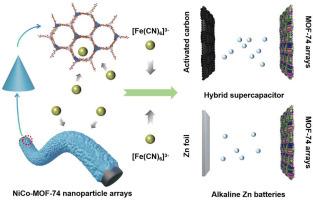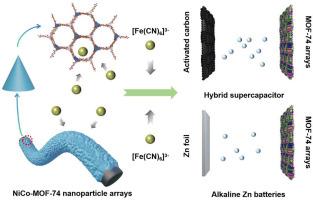NiCo-MOF-74 nanoparticle arrays with electrolyte-enhanced interface dynamics for high-rate aqueous energy storage
IF 5.6
3区 材料科学
Q1 ELECTROCHEMISTRY
引用次数: 0
Abstract
Owing to their large surface area, adjustable framework structures, and multiple redox-active sites, metal-organic frameworks (MOFs) have emerged as attractive candidates for electrodes in aqueous energy storage systems. However, most MOFs suffer from poor electrical conductivity, structural fragility, and limited electrochemical activity, which inhibit their practical application. Herein, we report a novel three-dimensional synergistic regulation strategy to construct high-performance MOF-based electrodes. Specifically, we demonstrate for the first time the in situ growth of NiCo-MOF-74 nanoparticle arrays on flexible carbon cloth via a one-step solvothermal method. Unlike conventional MOF nanowire arrays, the nanoparticle array architecture offers enhanced interfacial contact, shortened ion transport pathways, and superior structural robustness. Density functional theory (DFT) calculations reveal that Co incorporation narrows the bandgap and improves electronic conductivity, supporting the rational design of bimetallic MOF-74 structures. Furthermore, by optimizing the Ni/Co ratio and introducing a redox-active electrolyte additive (K3[Fe(CN)6]), the electrochemical kinetics and capacity are greatly enhanced. The optimized electrode delivers a record-high specific capacity of 362.2 mAh g-1. The corresponding hybrid supercapacitor (HSC) based on NiCo-MOF-74 exhibits a high energy density of 44.7 Wh kg-1 and outstanding cycling stability (92.5 % after 10,000 cycles). The corresponding alkaline zinc battery (AZB) also shows an excellent energy density of 312.3 Wh kg-1 with a capacity retention rate of 92 % after 1000 cycles. This work not only introduces a scalable strategy for constructing MOF nanoparticle arrays, but also provides insights into the structure-composition-interface synergy in aqueous energy storage systems.


具有电解质增强界面动力学的NiCo-MOF-74纳米颗粒阵列用于高速率水储能
金属有机框架(mof)由于其大表面积、可调节的框架结构和多个氧化还原活性位点,已成为水储能系统中极具吸引力的电极候选材料。然而,大多数mof存在导电性差、结构脆弱和电化学活性有限等问题,制约了它们的实际应用。在此,我们报告了一种新的三维协同调节策略来构建高性能的mof基电极。具体来说,我们首次通过一步溶剂热法在柔性碳布上原位生长了NiCo-MOF-74纳米颗粒阵列。与传统的MOF纳米线阵列不同,纳米颗粒阵列结构提供了增强的界面接触、缩短的离子传输途径和优越的结构坚固性。密度泛函理论(DFT)计算表明,Co的加入缩小了带隙,提高了电子导电性,支持了双金属MOF-74结构的合理设计。此外,通过优化Ni/Co比和引入氧化还原活性电解质添加剂K3[Fe(CN)6],大大提高了电化学动力学和容量。优化后的电极提供创纪录的362.2 mAh g-1比容量。相应的基于NiCo-MOF-74的混合超级电容器(HSC)具有44.7 Wh kg-1的高能量密度和出色的循环稳定性(10,000次循环后92.5%)。相应的碱性锌电池(AZB)也显示出良好的能量密度312.3 Wh kg-1, 1000次循环后容量保持率为92%。这项工作不仅介绍了构建MOF纳米颗粒阵列的可扩展策略,而且还提供了对水储能系统中结构-成分-界面协同作用的见解。
本文章由计算机程序翻译,如有差异,请以英文原文为准。
求助全文
约1分钟内获得全文
求助全文
来源期刊

Electrochimica Acta
工程技术-电化学
CiteScore
11.30
自引率
6.10%
发文量
1634
审稿时长
41 days
期刊介绍:
Electrochimica Acta is an international journal. It is intended for the publication of both original work and reviews in the field of electrochemistry. Electrochemistry should be interpreted to mean any of the research fields covered by the Divisions of the International Society of Electrochemistry listed below, as well as emerging scientific domains covered by ISE New Topics Committee.
 求助内容:
求助内容: 应助结果提醒方式:
应助结果提醒方式:


